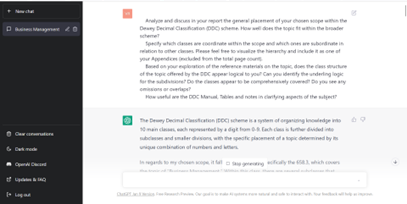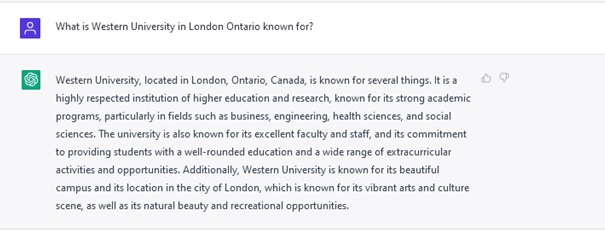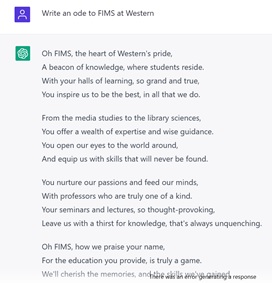Suggested Citation: Rubin, Victoria L. (26 January 2023). Mini-Study 1. ChatGPT Assessment for Assignment Plagiarism. Open Working Notes, In Assessments of Text-Generating AI. The LiT.RL Project, University of Western Ontario, Available at https://victoriarubin.fims.uwo.ca/research/projects/assessments-of-text-generating-ai-2023/mini-study-1-chatgpt-assessment-for-assignment-plagiarism/

Problem Statement: There has been a concern about potential student plagiarism by using ChatGPT (ChatGPT Jan 9 Version) in completion of their assignments. There is much coverage of this OpenAI app in the media, clever tricks in delivering AI-written speeches by politicians and journalists. It might lead to temptation for some tech-curious students to at least try it out. Some might use it for their upcoming assignment in a graduate MLIS course at FIMS. ESL students may use it for improvements of their language and argumentation skills.
Question: How does ChatGPT work? Can we easily distinguish a machine-written speech output from human writing?
A short answer: my initial assessment is that the system is easy to use and its automated output is barely distinguishable from standard human written samples produced from this assignment.
Reasons: Why might ChatGPT pass the Turing Test? (In other words, why would its output fool a reader into thinking it is produced by a human?) Primarily, the output is a topical fit to the queries, it is grammatically correct, it has internal cohesiveness of the “borrowed” arguments, it approximates reality, and it is usually appropriate to the requested style. In other words, such AI-based Speech Generation cleverly recombines pieces of pre-existing texts, based on an initial test.
My background: I specialize in NLP (Natural Language Processing) and NLG (Generation) is a part of it. I now work in NLD (Detection) for deception (fakes, like clickbait, satire and other falsehoods). In my early works, I paid attention to how recognizable AI is, as compared to the human writing, for example in human vs. machine summaries (in 2010) and Artificially Intelligent Conversational Agents in Libraries (2010). Around early 2019 and the invent of the LLM (Large Language Models) like BERT, most NLP tasks had a boost of about 10-15% in performace accuracies, and it revolutionized the field.
Procedures for this initial approach: I have a course that I teach in our MLIS program and I have used its first assignment on Dewey Decimal Classification (DDC)as a prompt in 3 stages simply “to see what comes back,” roughly speaking, and to warn my TA of potential patterns in this OpenAI’s output. I further improvised with formats and more generic prompts. Formats includes an assignment report (Figure 1), a critical op-ed, an ad for a university (Appendix A), a research proposal, an ode (Appendix B), a love letter, an assessment question, and a prompt to go on. (The exact sequence of inquiries and responses via ChatGPT’s user interface, in both textual format and screenshots, are available upon request.)
Initial Test-Run Results and Preliminary Observations:
- ChatGPT can be inaccessible due to overload (thus, students would need to pre-plan its use way in advance, at least at the first point of entry to get the app installed).
- The system requires both an email and phone for verification to set it up, but is otherwise easy to use. (This is both a privacy issue and a potential security trace, if we had a way of black-listing institutional emails. Not sure a blanket ban is a way to go, and is even feasible, but tracing is worth exploring.)
- The level of complexity in accessing the interface is rather low. All it requires is no fear of IT and a good motive to use it. Usability-wise, ease-of-use is a feature. The mode is interactive.
- I believe there is an option to “go dark” (perhaps erase prior sessions, noted at the bottom, but it is not encouraged or even easily noticeable, as the developers must use input data for further training and system improvements. It is a standard beta release mode, that of exploratory and experimental nature in software development. Its scale is unusual. This also means they are likely to monetize it, eventually, if not soon, and put it behind a paywall, once enough attention is harnessed.
- Tech support videos are available via https://openai.com/blog/chatgpt/.
- Plainly speaking, it is an online website link that opens up a separate tab with a personalized session. See Figure 1 below.

7. In a session, ChatGPT system remembers the theme, and relates it to previous context.
8. Output comes in short bursts of about 250 characters. This space allows for 3-5 paragraphs.
9. For assignment writing specifically, the output is written to form, e.g., observe an opening and a conclusive statements/paragraph.
10. The system can “continue” if it stops and runs out of some set space. (So, a space limit is not a determinant of a human).
11. It doesn’t use citations naturally.
12. The system can output cited works and discuss their importance without any trouble, if requested (e.g., Lankes, Buckland, Bowker, etc.) (CompExam graders, beware!)
13. It gets repetitive, it stays shallow or at least summative.
14. It reuses abbreviations unnecessarily or comes back to full terms where a human might skip it, e.g., The Dewey Decimal Classification (DDC), and EDI.
15. It can easily fool a grader to give this specific DDC assignment a reasonably high grade (around 75 – 80), and the points are valid, can be seen as progressive (depending on the prompt, of course) or at least generally accepted in the field.
16. It corrects for an extreme affect (such as an unbalanced view), see my request for a love letter it was post-critiqued without an explicit request, but it’s based on my prior input.
17. It also seems to time out, or it really didn’t want to consider my last self-serving prompt.
18. All citations have to be verified, as it tends to attribute claims to non-existing works. It makes up quotes, works, and mis-attributes sources.
19. Generated texts contain scrambled facts, with descriptions of plausible but inaccurate events.
20. Once the correct answer is known, it is easier to see mistakes and other deviations from truths.
Conclusions: ChatGPT’s system output is a close imitation of human writing in various formats. It is creative, yet still pattern-based and repetitive. It can impress. It can fool. It can be disruptive in education. It could be treated as adversarial technology, if its use is opaque or undisclosed to the reader of the generated texts. It could be embraced as assistive technology, if its use is fully disclosed and explained, in the spirit of transparent AI. ChatGPT may be somewhat volatile: if the system is no longer mass-distributed and openly accessible (e.g., it can be pay-walled providing no free easily-accessible option), at the same time if other systems follow suit and become available for pay, the potential issue becomes that of paid AI-generated plagiarism. It there is an uptake of these system by students, educators have to stay one step ahead and decide how to treat these technologies: as adversarial or assistive. Framing the problem can help inform policies and suggested guidelines to these systems use (or non-use).
Beyond destabilizing our educational system with potentially unrecognizable plagiarism attempts, there are greater dangers in the adversarial use of AI-based text generating systems for mass dis-informing and digital propaganda campaigns. We expect to be able to search for factual, accurate, truthful information. In our legal system, in public communications from health officials and scientific experts, we expect to be able to recognize expert opinions, and we should be able to trust them and get advice from them. With ChatGPT’s superb BS-ing and plainly making stuff up, the society is now up against “automated liars” and AI-based tools of disinformation, in the hands of anyone who knows how to access a link and type in a query. Distorted narratives can circulate around the social media. If the digital media is flooded with auto-generated alternative facts, in large volumes, it will only get harder for us all to tell wade through the muck and to tell authoritative sources. Proliferation of inaccurate statements, false reports, and purposefully scrambled ideas – just for the fun of it – is dangerous. Vulnerable populations can be skilfully targeted with personalized direct messaging, with ease, flourish, and persuasive powers of the greatest writers, from Shakespeare to Gerry Seinfeld. More and more people will get confused. In short, AI-based communication tools should be considered not just for their novelty, ease of use, and exciting potential, but also for their unintended consequences and harms to the society.
Last Update: 01/26/2023
Appendix A.
VR: What is Western University in London Ontario known for?

Western University, located in London, Ontario, Canada, is known for several things. It is a highly respected institution of higher education and research, known for its strong academic programs, particularly in fields such as business, engineering, health sciences, and social sciences. The university is also known for its excellent faculty and staff, and its commitment to providing students with a well-rounded education and a wide range of extracurricular activities and opportunities. Additionally, Western University is known for its beautiful campus and its location in the city of London, which is known for its vibrant arts and culture scene, as well as its natural beauty and recreational opportunities.
Appendix B.
VR: Write an ode to FIMS at Western

Oh FIMS, the heart of Western’s pride,
A beacon of knowledge, where students reside.
With your halls of learning, so grand and true,
You inspire us to be the best, in all that we do.
From the media studies to the library sciences,
You offer a wealth of expertise and wise guidance.
You open our eyes to the world around,
And equip us with skills that will never be found.
You nurture our passions and feed our minds,
With professors who are truly one of a kind.
Your seminars and lectures, so thought-provoking,
Leave us with a thirst for knowledge, that’s always unquenching.
Oh FIMS, how we praise your name,
For the education you provide, is truly a game.
We’ll cherish the memories, and the skills we’ve gained,
For the rest of our lives, you’ll always remain.
You are the future of media and information,
And we’ll be forever grateful, for your education.
So here’s to you, FIMS, our beloved school,
We’ll forever sing your praises, as a golden rule.